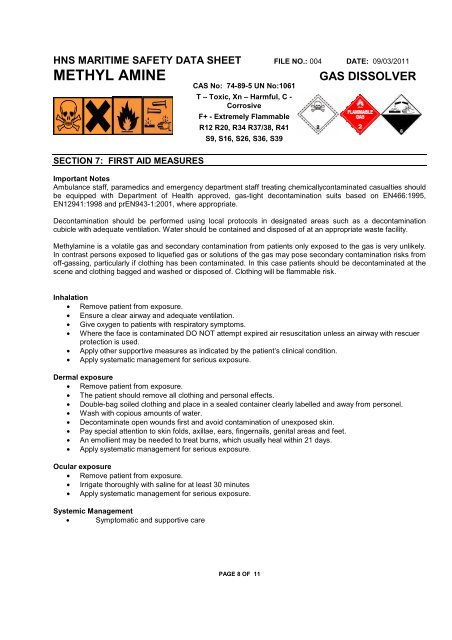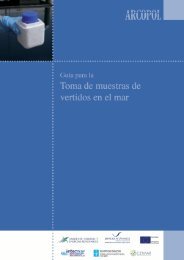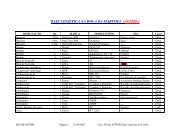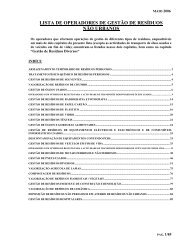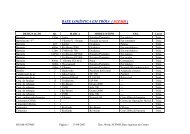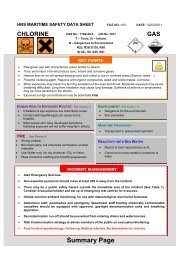methyl amine gas dissolver - Arcopol.eu
methyl amine gas dissolver - Arcopol.eu
methyl amine gas dissolver - Arcopol.eu
Create successful ePaper yourself
Turn your PDF publications into a flip-book with our unique Google optimized e-Paper software.
HNS MARITIME SAFETY DATA SHEET FILE NO.: 004 DATE: 09/03/2011<br />
METHYL AMINE<br />
SECTION 7: FIRST AID MEASURES<br />
CAS No: 74-89-5 UN No:1061<br />
T – Toxic, Xn – Harmful, C -<br />
Corrosive<br />
F+ - Extremely Flammable<br />
R12 R20, R34 R37/38, R41<br />
S9, S16, S26, S36, S39<br />
GAS DISSOLVER<br />
Important Notes<br />
Ambulance staff, paramedics and emergency department staff treating chemicallycontaminated casualties should<br />
be equipped with Department of Health approved, <strong>gas</strong>-tight decontamination suits based on EN466:1995,<br />
EN12941:1998 and prEN943-1:2001, where appropriate.<br />
Decontamination should be performed using local protocols in designated areas such as a decontamination<br />
cubicle with adequate ventilation. Water should be contained and disposed of at an appropriate waste facility.<br />
Methyl<strong>amine</strong> is a volatile <strong>gas</strong> and secondary contamination from patients only exposed to the <strong>gas</strong> is very unlikely.<br />
In contrast persons exposed to liquefied <strong>gas</strong> or solutions of the <strong>gas</strong> may pose secondary contamination risks from<br />
off-<strong>gas</strong>sing, particularly if clothing has been contaminated. In this case patients should be decontaminated at the<br />
scene and clothing bagged and washed or disposed of. Clothing will be flammable risk.<br />
Inhalation<br />
• Remove patient from exposure.<br />
• Ensure a clear airway and adequate ventilation.<br />
• Give oxygen to patients with respiratory symptoms.<br />
• Where the face is contaminated DO NOT attempt expired air resuscitation unless an airway with rescuer<br />
protection is used.<br />
• Apply other supportive measures as indicated by the patient’s clinical condition.<br />
• Apply systematic management for serious exposure.<br />
Dermal exposure<br />
• Remove patient from exposure.<br />
• The patient should remove all clothing and personal effects.<br />
• Double-bag soiled clothing and place in a sealed container clearly labelled and away from personel.<br />
• Wash with copious amounts of water.<br />
• Decontaminate open wounds first and avoid contamination of unexposed skin.<br />
• Pay special attention to skin folds, axillae, ears, fingernails, genital areas and feet.<br />
• An emollient may be needed to treat burns, which usually heal within 21 days.<br />
• Apply systematic management for serious exposure.<br />
Ocular exposure<br />
• Remove patient from exposure.<br />
• Irrigate thoroughly with saline for at least 30 minutes<br />
• Apply systematic management for serious exposure.<br />
Systemic Management<br />
• Symptomatic and supportive care<br />
PAGE 8 OF 11


